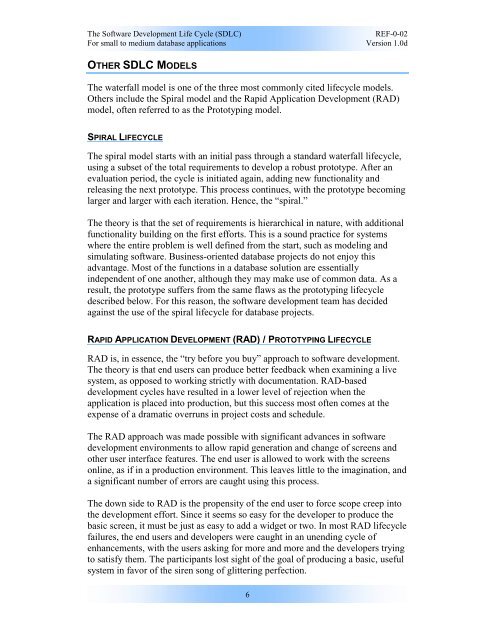sdlc
Create successful ePaper yourself
Turn your PDF publications into a flip-book with our unique Google optimized e-Paper software.
The Software Development Life Cycle (SDLC)<br />
REF-0-02<br />
For small to medium database applications Version 1.0d<br />
OTHER SDLC MODELS<br />
The waterfall model is one of the three most commonly cited lifecycle models.<br />
Others include the Spiral model and the Rapid Application Development (RAD)<br />
model, often referred to as the Prototyping model.<br />
SPIRAL LIFECYCLE<br />
The spiral model starts with an initial pass through a standard waterfall lifecycle,<br />
using a subset of the total requirements to develop a robust prototype. After an<br />
evaluation period, the cycle is initiated again, adding new functionality and<br />
releasing the next prototype. This process continues, with the prototype becoming<br />
larger and larger with each iteration. Hence, the “spiral.”<br />
The theory is that the set of requirements is hierarchical in nature, with additional<br />
functionality building on the first efforts. This is a sound practice for systems<br />
where the entire problem is well defined from the start, such as modeling and<br />
simulating software. Business-oriented database projects do not enjoy this<br />
advantage. Most of the functions in a database solution are essentially<br />
independent of one another, although they may make use of common data. As a<br />
result, the prototype suffers from the same flaws as the prototyping lifecycle<br />
described below. For this reason, the software development team has decided<br />
against the use of the spiral lifecycle for database projects.<br />
RAPID APPLICATION DEVELOPMENT (RAD) / PROTOTYPING LIFECYCLE<br />
RAD is, in essence, the “try before you buy” approach to software development.<br />
The theory is that end users can produce better feedback when examining a live<br />
system, as opposed to working strictly with documentation. RAD-based<br />
development cycles have resulted in a lower level of rejection when the<br />
application is placed into production, but this success most often comes at the<br />
expense of a dramatic overruns in project costs and schedule.<br />
The RAD approach was made possible with significant advances in software<br />
development environments to allow rapid generation and change of screens and<br />
other user interface features. The end user is allowed to work with the screens<br />
online, as if in a production environment. This leaves little to the imagination, and<br />
a significant number of errors are caught using this process.<br />
The down side to RAD is the propensity of the end user to force scope creep into<br />
the development effort. Since it seems so easy for the developer to produce the<br />
basic screen, it must be just as easy to add a widget or two. In most RAD lifecycle<br />
failures, the end users and developers were caught in an unending cycle of<br />
enhancements, with the users asking for more and more and the developers trying<br />
to satisfy them. The participants lost sight of the goal of producing a basic, useful<br />
system in favor of the siren song of glittering perfection.<br />
6



